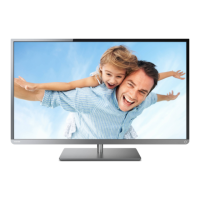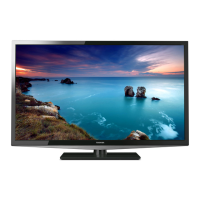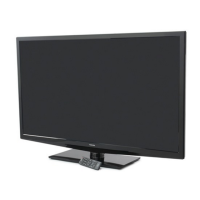
Do you have a question about the Toshiba 50L2300U and is the answer not in the manual?
| Screen Size | 50 inches |
|---|---|
| Display Type | LED |
| Resolution | 1920 x 1080 |
| Refresh Rate | 60 Hz |
| Smart TV | No |
| HDMI Ports | 3 |
| USB Ports | 1 |
| HDMI Audio Return Channel (ARC) | Yes |
| Built-in Wi-Fi | No |
Guidelines for safe television installation and usage to prevent accidents.
Instructions and recommendations for securely mounting the TV to walls or ceilings.
Essential warnings to reduce risks of fire, electric shock, and damage.
Recommendations for proper installation, maintenance, and servicing of the TV.
Key features of the TV and a guide to its installation, setup, and use.
Identification of buttons, ports on the TV's front, side, and back panels.
Description of common cable connectors required for connecting audio/video devices.
Instructions for connecting VCRs, antennas, cable TV, or camcorders to the TV.
Guide on connecting devices with HDMI or DVI outputs to the TV's HDMI input.
Explanation of how to control connected HDMI CEC devices using the TV remote.
Instructions for connecting digital audio systems using the TV's optical audio output.
Guide on connecting external analog audio amplifiers and speakers to the TV.
Steps for connecting a PC to the TV via PC IN or HDMI terminals for display and audio.
Instructions on how to insert batteries into the TV's remote control.
Information on the optimal distance, angle for remote use, and its effective range.
Detailed description of each button on the TV remote control and its functions.
Overview of the TV's menu system structure and available options.
How to use the remote control buttons to move through and select menu items.
Step-by-step initial configuration for language, time zone, and input source.
Selecting menu language and configuring ANT/CABLE input source.
Process for automatically scanning and storing available TV channels.
How to manually enter and tune specific channels if the physical channel is known.
How to prevent specific channels from being viewed by skipping them.
Configuring audio settings for HDMI inputs, selecting between PC or HDMI audio.
Specifying the correct time zone and viewing TV status information.
How to choose which connected device's signal to display on the TV.
Customizing names for video input sources to easily identify connected devices.
Using the Channel Browser for easy navigation and selection of channels and inputs.
Creating and managing a list of favorite channels or inputs for quick access.
Adding, clearing, and managing the list of recently tuned channels and inputs.
Quickly switching between the two most recently viewed channels.
Adjusting the display size and aspect ratio of the picture for different program formats.
Adjusting the picture position for TheaterWide modes to view hidden areas like captions.
Automatically selecting the optimal picture size based on the input signal.
Selecting preset picture modes (Dynamic, Standard, Movie, Game, PC) for optimal viewing.
Fine-tuning picture settings like Backlight, Contrast, Brightness, Color, Tint, and Sharpness.
Displaying on-screen text for dialogue, narration, and sound effects of programs.
Customizing the appearance of closed captions, such as color, size, and opacity.
Controlling sound features including muting, volume levels, and audio output settings.
Switching between audio tracks on digital channels for different languages or commentary.
Fine-tuning audio settings like Bass, Treble, and Balance for preferred sound.
Explanation of Audyssey EQ and ABX technologies for enhanced audio performance.
Setting or managing a PIN code required for accessing certain menus or features.
Blocking TV programs and movies based on rating systems to restrict content.
Obtaining and applying new rating systems for enhanced parental control capabilities.
Explanation of broadcast rating systems and their content themes for parental guidance.
How to view the rating information for the currently watched program using the INFO button.
Temporarily bypassing program lock mode for programs exceeding rating limits.
Preventing specific channels from being accessed without entering a PIN code.
Locking the TV's control panel to prevent accidental changes to settings.
Adjusting image parameters when connecting a PC to the TV for optimal display.
Configuring audio output for PC input, enabling sound from the PC or disabling it.
Fine-tuning picture quality using advanced settings like ColorMaster, DynaLight, and Noise Reduction.
Initial steps and general advice for diagnosing and resolving TV problems.
Common issues related to picture display, such as no picture, incorrect color, or aspect ratio changes.
Troubleshooting audio issues like noisy sound, poor sync, or no sound at all.
Resolving issues with tuning channels, including Auto Tuning, Manual Tuning, and channel memory.
Troubleshooting issues related to closed caption display, including signal problems.
Common issues encountered with HDMI connections, including cable compatibility and legacy sources.
Technical details about the TV's broadcast reception systems (NTSC, ATSC, Digital Cable).
Information on power requirements, maximum current, consumption, and audio power output.
Details on speaker dimensions and the types of audio input/output terminals available.
Physical dimensions of the TV models and specifications for the PC input terminal.
List of included accessories and acceptable signal formats for PC IN and HDMI inputs.
Technical specifications for various HDMI signal formats supported by the TV.
Details on the software components used in the TV and their associated license agreements.
Specifics of End-User License Agreements for pre-installed software components.
The license terms for the FreeType Project software used in the television.
The GNU General Public License terms for specific software components included with the TV.












